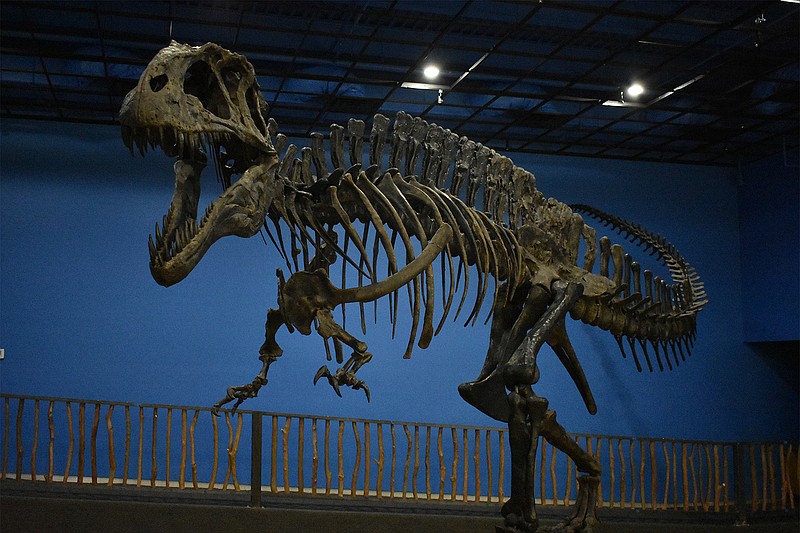IDABEL, Okla.-The fearsome visage of the Acrocanthosaurus has been hidden away at Museum of the Red River for many months, but no more do those spectacular jaws fail to see the light of day.
After an extensive, three-year reconstruction project at MoRR, all of the museum's public spaces will be open to visitors by the end of April-as always, with free admission.
Photo Gallery
Cocktails for Cancer
Friends and supporters of a local running team, Team in Training, gathered at Lulav to raise money for the Leukemia and Lymphoma Society and support the runners.
That includes the Dinosaur Gallery, where the Acro resides in all its beastly glory, roughly 14 feet tall and 40 feet long, similar in appearance to the infamous Tyrannosaurus rex that's wreaked havoc on peaceful thoughts for so many years.
In addition to being an apex predator, the Acro is also Oklahoma's state dinosaur. The cast now at the Museum of the Red River was copied from an Acrocanthosaurus skeleton discovered just miles from Idabel by two amateur paleontologists back in 1983.
Acro's eventual arrival at MoRR has a local tie, as well, because local grade school students raised money to ensure it came to the museum.
Now, the mighty bones are back, reassembled and ready to inspire wonder at the MoRR's Dinosaur Gallery. Other galleries have opened, including the Founder's Gallery, where the best of the best culled from the vast collection are displayed.
MoRR may be home to a significant dinosaur draw, but its main purpose as an ethnographic art museum is to highlight artistic and archaeological finds from all over the world, including cultural objects from people native to the Americas.
In order to properly showcase and store all of that, reconstruction projects at MoRR started in the spring of 2016. Initially, the aim was to simply increase storage, considering the growth in the museum's collections. Storage was nearly full.
Other aspects of reworking the museum were added. Logistical delays popped up as reconstruction continued. A glass pyramid constructed at the front of the MoRR has taken longer than expected, for example, because of its unique complexity.
"It was only going to last a year. We obviously ran into a couple of delays, but we did add a lot of new space that wasn't originally a part of that construction plan so that's part of the delay," said Brian Hendershot, MoRR's head of communications and outreach.
When construction is finished, the museum will total more than 50,000 square feet. The collection itself totals nearly 35,000 objects from six different continents, and it's growing all the time.
"That large of a collection is sort of one of the reasons we started to expand," Hendershot said. Because they had the time, on-hand work crews and money to do the job, MoRR decided to add more to the construction plan.
But as of this past week, work crews were completing most of the finishing touches to get everything ready and open, including reassembling Acro. A bit of construction may continue, but it won't hinder the visitor experience, Hendershot said, including those visiting Acro, which holds a special place at MoRR.
"It is the most intact specimen of Acrocanthosaurus ever found, so that's also significant," Hendershot said. The Dinosaur Gallery now is several times larger than before. A side gallery adds context to dinosaur knowledge, and then on another side a reception area awaits visitors with a couple of major works of art.
The art may not be dinosaur-themed, but it fulfills other parts of the MoRR mission and beautifies the space. One work was created by respected Quinalt/Isleta-Pueblo artist Marvin Oliver: an 8-foot-tall glass totem. Imagine the light shining into it, Hendershot urged.
The inclusion of such gorgeous permanent art fits with the museum's interest in contemporary art, where MoRR has dabbled in recent years with temporary art exhibits.
Room for contemporary art is just one of the benefits of the reworked museum.
"The big thing for the public is more space," Hendershot said. "For us, the big thing was collection storage. Collections is really important to us. It gives us a lot of security from a lot of different things."
MoRR was at 98% capacity when renovations began. At the time, they had around 30,000 objects, roughly 5,000 fewer than they have now. Many donations come from private collectors, both inside and outside the country. Museums show a small percentage of what they have, and that is particularly true at MoRR, Hendershot said.
"In our collections we've got some really fantastic areas. We have one of the best contemporary Amazonian featherwork collections in the United States. You're not going to see, at least publicly, a better collection of Southeast basketry, so that's your Choctaw, Creek, Chickasaw. Caddo ceramics, we've probably got one of the best ones, too," Hendershot said.
What happened to Acro while construction was ongoing?
"We just sort of disassembled her and just sort of moved her around the building as spaces were completed," Hendershot said, comparing Acrocanthosaurus to T. rex by saying the arms on it were marginally longer. That's how he describes it to youngsters.
Short arms or not, Acro was boss. "It was top of the food chain," Hendershot said, noting for children it's fun to see. "They just lose their marbles every time they see it," he said. "We'll be excited to have that back."
The old Acrocanthosaurus-whose return was announced on MoRR's Facebook page with a simple, dramatic "She's back" and a photo-brings with it the ability to imagine a creature that roamed these parts at 14,000 pounds more than 113 million years ago. The name means "high-spined lizard."
"We ended up with the cast, and the cast is as good as the original. Actually when the scientific reports were written about the dinosaur, the paleontologists used measurements from the cast, not from the original fossil, because that's how good that cast was," said Henry Moy, MoRR's director.
The original fossil is the most complete Acrocanthosaurus ever found at 50 percent, including an entire skull. "The only full skull ever found of Acro," Moy said, noting its discovery redefined what Acro was.
Moy remembers when local students brought pennies, nickels and dimes together to raise thousands of dollars and help fund the acquisition of Acro. They had a stake in seeing Acro here.
"I challenged them because this came from the kids, this came from the schools," he said. They let it be known that the dinosaur needed to be in McCurtain County.
And when it came here, its presence doubled and tripled the MoRR's annual attendance.
"We are a museum for the community. Who knew there was a dinosaur here? Nobody, nobody," Moy said. "And so the idea that we would help inspire the next generation of paleontologists, the kids who would go to school, who actually carry their interest into adulthood, they could always come back here that was one of the biggest arguments to why we should have it," Moy said.
Now Acro's back, ready to inspire wonder, and maybe few goosebumps, at Museum of the Red River.
(On the Net: MuseumoftheRedRiver.org.)


